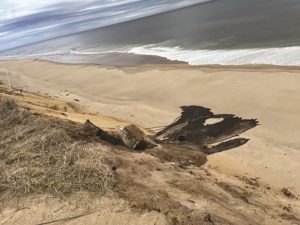WELLFLEET — On beaches along this eroding coastline, it’s common to stumble upon strange artifacts, from PVC pipes to electrical wires to concrete rubble. The most recent discovery: a broken septic tank, its contents — so old as to no longer be dangerous — spilled on the surrounding sand.
Melinda Krasting was surprised to get a call from Wellfleet Health and Conservation Agent Hillary Greenberg-Lemos on April 1 about her oceanside property off Cliff Road — the spot where she used to have a house. Following high winds, an old septic tank buried on the property and not recorded on site plans had fallen from the dune between White Crest Beach and Lecount Hollow.

Sewage spills contain bacteria, viruses, and parasites that can cause serious illnesses such as hepatitis and gastroenteritis. Such spills are rare here because records on septic systems are kept by home owners and towns, and, in the case of properties within its boundaries, by the Cape Cod National Seashore. Typically, their locations are known. And when a house is demolished or moved, the tanks are removed or pumped dry and filled with clean sand, according to Greenberg-Lemos.
Krasting bought her house off Cliff Road in 1998 and moved it away from the ocean twice as the backshore dune eroded, each time taking the tanks she knew existed. The tank that fell onto the beach predates Krasting’s ownership of the property, she said, though she is now arranging for its removal. But she worries that the National Seashore is unprepared for circumstances like these.
Greenberg-Lemos confirmed that this septic tank was not something Krasting could have known about. “It wasn’t shown on any previous plans we have on file,” Greenberg-Lemos said. “We believe that it’s really old. There was no odor associated with the material. The tank is less hazardous because it’s been sitting there for so, so long.”
Eleven days after it fell, the septic tank still sat on the beach. As of Tuesday morning, April 12, Krasting had received estimates from three excavation companies. One company was not equipped to remove it. The waste management company Clean Harbors wanted to build a sand ramp to remove the tank and waste for $75,000, Krasting said.
“I don’t think they understood how old the material was,” Krasting said. She chose Winkler Construction & Crane Co., based in Truro, to do the job for an estimated $10,000, she said.
This is not the first erosion-related problem Krasting has faced. After having moved her former house twice, by 2013, there was no more space to move it further. The house was condemned, and she sold it to her neighbor, Robert Boehringer, for one dollar.
Krasting then moved to Truro but negotiated with the Seashore to keep a wooden deck on the last remnants of her property. “It was heaven,” she said. “For the last nine years I’ve been spending time on the deck almost every day.” But January’s storms destroyed the deck and made the roads to her land inaccessible. She hasn’t visited since.
To carry out the cleanup, Krasting has had to obtain permits from the Seashore. That process typically takes a week, unless there’s an immediate threat, said Seashore Supt. Brian Carlstrom. A process is followed, he said, to be sure the debris is removed “in the least impactful way.”
A special-use permit is required to bring the needed heavy equipment onto the beach and “a bird monitor, because the plovers are out,” Greenberg-Lemos said. The town may also need to issue a permit for use of a town landing, she added. By Tuesday, the Seashore was ready to issue the special-use permit but was waiting on documentation from the contractor.
A second old septic tank, also not shown on site plans, was recently discovered higher up on the dune. It will be removed, also by Winkler and at Krasting’s expense, at the same time as the fallen one, Greenberg-Lemos said. “Once it falls, it’s way more difficult to remove,” she noted.
To Krasting, the fallen septic tank is a harbinger of larger problems to come. “It’s scary to think what could happen as more areas erode,” she said. “Think of what could be uncovered at the old Air Force base.”
Greenberg-Lemos said another incident where cleanup required the Seashore’s approval happened a little farther up the coast when an asphalt driveway landed on the beach.
More unknown septic tanks or other objects may be exposed by erosion. The coastal bank near Krasting’s property has sometimes eroded by as much as 15 feet in a year, said Gordon Peabody, director of Safe Harbor Environmental Services in Wellfleet. But addressing related problems is not easy, Peabody said; it “often requires a jurisdictional lasagna of local, state and federal authorities.”
While a septic tank over the edge has gotten our attention in the last week, Center for Coastal Studies Marine Debris and Plastics Program Manager Laura Ludwig says it’s not her biggest concern. What she is more worried about is “the untold number of wires, cables, PVC pipes, polypropylene tubing, and plastic trash that have been exposed as a result of the sloughing cliffs.”
That’s because those objects become more hazardous the longer they sit, undergoing UV degradation and breaking down into microplastics that are harmful to aquatic life and humans.
While the Center for Coastal Studies has deployed numerous volunteers on an intensive clean-up program, “We still can’t handle it,” Ludwig said. “The Park can’t handle it either. It’s going to be an ongoing effort to try and resolve this.”
Over the last few months, the endangered Ballston Beach house, this old septic tank, and the thousands of pieces of plastic found on the shorelines are “all pointing to the same questions,” Ludwig said. “Whose beach is it? Who cares about it? What can we all do about it?”



